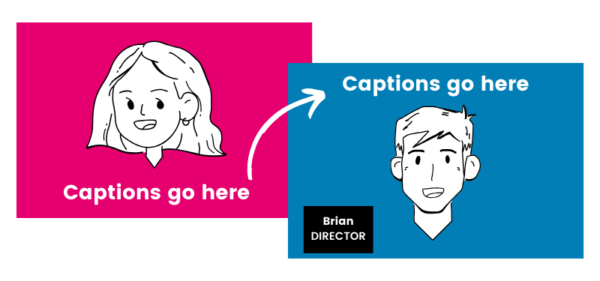3Play’s Patent Playbook: Transforming Caption Placement at Scale with Automated Closed Caption Positioning
3Play’s Patent Playbook blog series tells the stories behind our patented technology. Learn how 3Play Media’s Research and Development (R&D) teams are spearheading innovation in accessibility tech and creating breakthroughs in the media accessibility industry at large.
Captioning Best Practices for Media & Entertainment [Free eBook]
In this Patent Playbook blog, we’ll explore how 3Play Media is disrupting traditional caption positioning workflows with our patented Automatic Vertical Caption Placement solution. We will review the state of caption placement before our team’s developments, learn the story behind the Automated Caption Positioning Systems and Methods patent, and discover the impact our caption positioning technology has made on the media accessibility industry.
What is Caption Positioning?
Vertical caption positioning, or caption placement, is the act of moving captions on a video to avoid the obstruction of on-screen graphics, text, or a speaker’s face. Occasionally, horizontal caption placement may be used to indicate speaker identification. Caption positioning plays a critical role in video accessibility best practices and ensures all on-screen information can be read and understood.
The State of Caption Positioning & Placement Before 3Play
Before the development of Automatic Vertical Caption Placement, the process of moving captions above graphics or lower thirds was entirely manual. For years, positioning capabilities were only available to professional closed captioners through specialized captioning software, which meant that complex technology and scalability issues gated both captioning customers and users.
Up until the early 2010s, most U.S. regulations and requirements for captioning focused on the presence of captions rather than their quality or turnaround, so caption placement was largely a concern for broadcast television and other traditional media.
The FCC Mandates Caption Placement
In February 2014, the Federal Communications Commission (FCC) released a declaratory ruling on closed captioning quality standards for video programming. Caption placement was included as a major part of these quality standards, with the FCC stating:
These caption placement directives were nothing new for broadcasters and traditional media, many of whom had been following these best practices for years. However, the ruling did draw greater attention to the necessity of vertical caption placement and its role in ensuring the accessibility of other on-screen graphics and text, especially for streaming media and other online video content.
How the CVAA Fits Into the Caption Positioning Story
In addition to the FCC’s release of caption quality standards, the 21st Century Communications and Video Accessibility Act (CVAA) phased in a series of captioning requirements and deadlines around the captioning of live and near-live video clips for online and streaming video between 2014 and 2017. The CVAA requirements created very short timeframes for the origination and postback of captions on IP-delivered clips. Combined with the FCC’s caption quality standards, these requirements created a challenge for producers tasked with captioning and formatting thousands of online video clips within mere hours to comply with the CVAA and FCC.
During this time, caption placement and positioning options expanded through the development of amateur-friendly video software and applications, such as Adobe Premiere Pro or YouTube. While this opened up further opportunities for DIY captioning, caption positioning remained a slow and manual process. At the time, no solution existed for the quick captioning and proper positioning of online video clips at scale to meet both the FCC quality standards and CVAA live and near-live programming regulations.
Why Did Our Team Develop a Caption Placement Solution?
The release of the CVAA’s near-live video captioning requirements for online video clips, along with the FCC’s caption quality standards, implicated a broad range of content to comply with stricter captioning regulations. In particular, media companies and networks producing large volumes of clips and content for online publishing and streaming were now pushed to create and format captions for thousands of clips each day on extremely tight 2-hour turnarounds.
This created a need for an automated, efficient solution for captioning and formatting large volumes of streaming video and online clips at scale. However, there were no viable alternatives to the reliance on professional captioning software for caption placement other than DIY or in-house methods. Each of these solutions remained manual, time-consuming, and costly.
With this top of mind, and a nuanced understanding of the variety of customer use cases and needs, our Research & Development (R&D) team went to work, building an automated caption placement solution that could power FCC and CVAA compliance at scale. Using captioning best practices and manual caption placement data as a guide, they developed a model for predicting the probability of the presence of text on video.
Innovating Caption Placement Through Automation
Innovation lies at the heart of 3Play Media’s core values. From our beginnings at MIT in 2008, we’ve aimed to revolutionize media accessibility solutions across industries. Our pursuit of innovative technology has produced a range of patents, including Automated Caption Positioning Systems and Methods, also known as Automatic Vertical Caption Placement.
Automatic Vertical Caption Placement helps prevent the obstruction of captions and important lower-third graphics and text on a video. Powered by an algorithm, 3Play’s automated Vertical Caption Placement technology monitors text-like patterns and images, then moves the captions to the top of the screen to avoid covering important information on the bottom of the screen.

How Automatic Vertical Caption Placement Works
3Play’s Automated Caption Positioning Systems and Methods patent discloses, among other technologies, the automated repositioning of caption frames based on the detection of critical visual information (such as text) on video frames.

The algorithm used for this solution does not “read” text but rather determines the probability that text-like patterns are present in a live or recorded video. The algorithm then searches across the time of the video and compares pixel location in each frame, computing a time-dependent probability for the text.
If the time-dependent text probability is high enough, the algorithm will check for burned-in text at the top of the video over the same time region. The bottom and top text probabilities are compared, and if the bottom probability is higher, captions are moved to the top of the video. If the top probability is higher than the bottom probability, the captions remain in the bottom position.
Finally, the algorithm applies time and continuity constraints to areas in which repositioning will occur. What this means is that our technology intelligently monitors the presence of repositioned captions and then follows best practices for caption positioning to create visual stability: moving all parts of a full sentence to the top or keeping a short sentence between top-positioned captions at the top to avoid a distracting bouncing effect in either recorded or live video.
3Play offers Manual Caption Placement using professional expertise for content that requires maximum accuracy. This service is most useful for ensuring that non-text graphics, symbols, or imagery remains unobscured by captions, since Automatic Vertical Caption Placement focuses on textual images.
An Automated, Patented Solution to Caption Positioning Requirements
Automatic Vertical Caption Placement is not a full replacement for Manual Caption Placement by a professional captioner, but it is a useful tool designed to help you meet CVAA and FCC standards quickly, cost-effectively, and at scale. By infusing human expertise and caption placement best practices into our innovative technology, 3Play inspires further technological developments and scalable, accessible solutions that propel the media accessibility industry forward.
Our Automatic Vertical Caption Placement solution has unlocked huge advantages for both customers and the captioning industry:
- Customers have a speedy, automated, and scalable solution for caption positioning that meets their compliance needs without complete reliance on manual processes.
- 3Play’s professional captioners and editors utilize caption placement automation to speed up the captioning process and focus on perfecting other quality aspects, such as accuracy and styling.
- The accessibility industry can leverage a trusted captioning solution designed with best practices, making inclusive video widespread and easier for all to achieve. 3Play’s technology gives end users a more accessible captioning experience while promoting the development of inclusive solutions that spark change and advancement in time-consuming manual captioning processes.
Beyond 3Play’s patented technology, our user-friendly approach to live and closed captioning is changing the industry for the better. Our captions are created with best practices from the Described and Captioned Media Program (DCMP) and tenured in-house experts. In addition to Automatic Vertical Placement, we also offer Manual Caption Placement services for files requiring a professional captioner’s attention. Most importantly, we guarantee a 99% accuracy rate on all caption files, no matter the difficulty, so that you have the peace of mind that your content will comply with all major accessibility laws.
Learn more about our reliable, scalable captioning solutions.
Further Reading

Subscribe to the Blog Digest
Sign up to receive our blog digest and other information on this topic. You can unsubscribe anytime.
By subscribing you agree to our privacy policy.







